Several varieties of red turnip are grown in communities dotting the Kiso mountain range in Nagano Prefecture. They have mostly been grown for household consumption, but now initiatives are being led by local women to produce them on a more organized scale and to dynamically link them together as their common treasure, bringing new energy to the aging communities.
Japanese Soul Food
The kabu, or turnip, is said to have made its way to Japan via China from around what is now Afghanistan. This must have happened before the eighth century, as citations can be found in both the Kojiki (Records of Ancient Matters) and the Nihon shoki (Chronicle of Japan), two ancient chronicles compiled in the eighth century. In the centuries that followed, the vegetable evolved into roughly 80 varieties native to different parts of Japan with varying colors, shapes, and tastes. This level of diversity is not seen either in China or among the European countries.
Its unparalleled diversity makes the kabu a representative traditional vegetable of Japan, alongside the daikon (Japanese radish), also of the brassica family. The many local varieties still grown across the country represent a soul food and a font of memory for the Japanese people.
Red and White
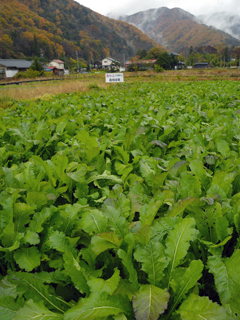
Local varieties of kabu are more numerous on the side of the Japanese archipelago facing the Sea of Japan, by way of which the vegetable must have come, than on the Pacific side. There are largely two groups of kabu : White varieties, such as the Tennoji kabu of Osaka, Shogoin kabu of Kyoto, and Kanamachi kokabu, are common in urban areas. By contrast, red varieties have mainly been grown in cold, mountainous regions.
The majority of Japanese turnips are red varieties, which grow well in highlands with low temperatures. The diversity of red turnips is partly due to geographic constraints on the exchange of seeds among neighboring villages posed by the mountains covering much of the land, which effectively isolated upland villages. But at the same time, it also directly reflects the great variety of climates and lifestyles from region to region.
Some red turnips, such as the Atsumi kabu and Hida akakabu, have gained prominence as local specialties, while others are about to die out as artifacts of a bygone lifestyle. The late Takashi Aoyama listed 67 major kabu varieties in his 1981 book Yasai: Zairai hinshu no keifu (Vegetables: The Genealogies of Indigenous Varieties). For 11 of these varieties, Web searches did not return a single hit, suggesting the possibility that some varieties may have gone extinct in the last quarter century.
Red turnips cope well with cold climates and little fertilizer, and their roots and stems can all be eaten. In the old days they were commonly grown in mountainous areas across Japan as subsistence crops, but the local economies and diets have undergone a sea change over the last decades. Meanwhile, initiatives are emerging in some communities to preserve the culture and lifestyle linked with the vegetable as an important heritage and reminder of the historical Japanese lifestyle. The red turnips grown in the Kiso area at the foot of Mt. Ontake serve as an exemplar.
Four Centuries in Kiso
The majestic Mt. Ontake lies on the border between Nagano and Gifu prefectures. The "red turnips of Kiso" refer to six varieties that have been grown in two towns and two villages at the foot of the mountain on the Nagano side: the Otaki kabu of Otakimura, Kaida kabu and Mitake Kurose kabu of Kisomachi, Hosojima kabu of Kisomura, and Yoshino kabu and Ashijima kabu of Agematsumachi. These turnips are said to have a history of four centuries, and recent research is coming to show that they comprise a unique group of varieties that are genetically distinct from the turnips of neighboring areas.
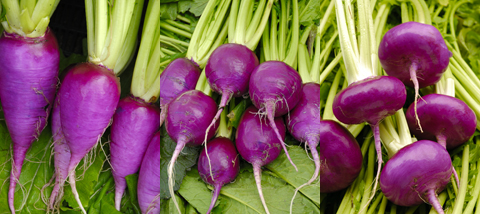
from left, Mitake Kurose kabu, Otaki kabu, Kaida kabu .
The red turnips of Kiso are closely related to the Atsumi kabu, reputed to be the best-tasting turnip in Japan, and have inherited its delicious traits. Their finely fibered root is crunchy, full of juice, and has a rustic aroma. It is delightful when pickled in sweetened vinegar or plain salt. Locals use the stems and leaves to make sunki zuke, a pickle fermented only with natural lactic acid bacteria without the use of salt.
The Kiso turnips are grown in valleys between the mountains, at altitudes ranging from 800 meters to 1,200 meters in the Kaida Highlands. Their total acreage only comes to 4.1 hectares, where about 50 tons of are grown annually.
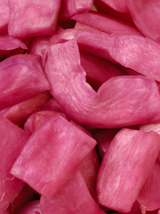
There are records indicating that the turnips were once grown by slash-and-burn farming, [1] and it seems reasonable to assume that red turnip cultivation went through several vicissitudes before arriving at the current method. Today they are grown either in fields regularly used for household production or in fallow terraced rice paddies in the mountains. Agricultural cooperatives and local governments are actively promoting the standardization of varieties and offering instruction in cultivation, but growers need to rely on chemical fertilizers and are having difficulty coping with crop disease.
The red turnips of Kiso are eaten in various ways. In processed form, they are most commonly marketed as sweet vinegar pickles. According to the book Kikigaki Nagano no shokuji (Oral Accounts of the Diet of Nagano), meanwhile, namasu of red turnip (pickled julienne red turnip) was offered to the gods and eaten as a festive food during the New Year and on other special occasions. Although sugar was not used, storing the turnips out in the winter fields increased their sugar content, and the pickles probably were surprisingly sweet. The vivid pink color of red turnip namasu likely led to the birth of the sweet vinegar pickles of today. In local homes, the turnips have traditionally also been pickled in rice bran, salted, or simmered.
Dwindling Production, Aging Communities
Kiso area statistics show that, as of 2005, there were 414 commercial farms in the four towns and villages where red turnip is grown (Kisomachi, Agematsumachi, Otakimura, and Kisomura). About 88 percent of them, or 365 farms, had annual sales of less than 500,000 yen. The 4 hectares of red turnip fields accounted for only 0.9 percent of the 434 hectares of non-paddy fields, excluding acreage used for subsistence production.
The average age of residents, moreover, is 67 years old. There are few economically viable agricultural pursuits in the area: One is the summer production of Chinese cabbage, which is mostly known as a winter vegetable, by taking advantage of the cool highland climate. There is also the breeding of Wagyu cattle, but little else besides. Given these limitations, it is difficult for young entrants to newly take up agriculture here.
According to accounts gathered in Otakimura, until a dozen or so years ago Kiso was something of a tourist destination, attracting Mt. Ontake hikers in the summer and skiers in the winter. But ski is no longer as popular as it once was, and depressing news abound, from municipal mergers to debts.
Still, there is some brighter and hopeful material: a plan to enliven the village by the hands of the over sixties. The idea is to bring retirees back to the village and help them lead a happy post-retirement life, whether or not that may include growing red turnips on a small scale. The grand design is to turn the village into a sustainable community in which the population circulates from village to city and back to village in 30 to 40 years. The dynamism being generated in this way is also giving the red turnip a new glimmer of hope.
Efforts Led by Women
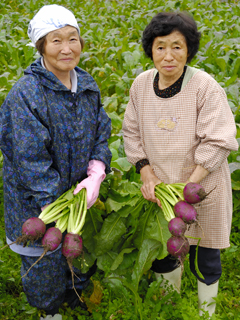
In each of the kabu -growing communities in the Kiso area, women are leading initiatives to add momentum to red turnip production. The women of each community are preserving the turnips unique to their town or village by selecting well-shaped specimens, replanting them, and harvesting their seeds.
In 2002 Otakimura hosted a lecture titled "The Future of the Past of the Otaki Kabu " by Professor Michio Oi of Shinshu University, who had already been promoting cultivar screening in Kaidamura. After this event the Otakimura residents, particularly elderly women, began to actively discuss the red turnips that they had been propagating at the household level as their common "treasure."
Eventually 50 individuals launched an Otaki kabu study group in the hope of restoring their local variety to its former glory. Shinshu University backed cultivar screening by the local moms, and three years later they saw the birth of a standardized cultivar called Otaki Amakabura.
The most unique aspect of the process was the screening method. Turnips were grown in a field specially set aside for the purpose, and each woman would vote for the specimens with the shape and form that best fit her personal image of an ideal turnip. The selected strains would then be propagated again, undergo another screening, and so forth.
Historically, red turnips were grown in individual households from home collected seeds and were thus very close to home in a real sense. In Otakimura, moreover, there had never been a common definition of a well-shaped kabu . For the first time, through their chats about the red turnip during the screening process, the village moms came to share the joy of creating "our village turnip."
Similar sentiments are gradually budding in other communities that produce red turnip. The local moms had always had the vague impression that their turnips were different from those grown in neighboring villages, putting them at a loss when asked to describe the shape of red turnips. But in fact the shape, as well as the taste, of the heirloom turnips that their families have grown for generations and passed down from mother to child is deeply engraved in their hearts. The women are coming to share these images with one another and joining hands to preserve the treasured vegetable.
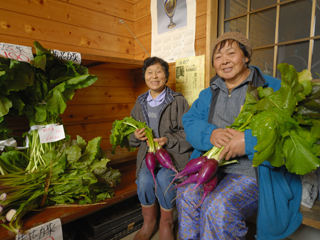
In the case of the Mitake Kurose kabu, the women's group Komakusa no Kai engages in food product development and sale at the Kuroda produce stand at Michi no Eki (Roadside Station) Mitake. The Mitake Kurose kabu was formerly produced in Kurose, a district that was flooded by the Makio Dam in 1958. It was long thought to have died out, until in 2002 it was discovered that one person had been growing it alone for 45 years since moving from Kurose to the Mitake district of Kisomachi. The Komakusa no Kai now leads efforts to expand its production and consumption.
The six turnips that had been grown in isolation in the highland communities of Kiso are beginning to be positively linked together through the Kiso Akakabu Net, launched in 2003 under the lead of the Nagano Prefecture Kiso Agricultural Extension Center. Villages and towns that had been blocked from active interaction by the rugged mountain range spreading at the foot of Mt. Ontake are now holding festivals focused on their turnips. The women of Kiso share the same group of kabu, and thus the same basic root, even though there may be minor differences. Slowly but surely, they are coming to see the red turnip as a common treasure of the entire region.
Photos: Kazuo Kikuchi
[1] We asked locals about their memories of slash-and-burn farming. It was evidently practiced in Agematsumachi until about a decade ago. In Otakimura it was practiced until around 1945, and red turnip seeds were sown after harvesting buckwheat. As the abovementioned book Vegetables also notes, slash-and-burn farming is said to have been common across the Shinshu region, of which Kiso is part.
